A compass needle will show which one of hte following directions at the earth's magnetic pole
1. Vertical
2. No particular direction
3. Bent at to the vertical
4. Horizontal
Two magnets of the same size and mass make respectively 10 and 15 oscillations per minute at a certain places. The ratio of their magnetic moments is
1. 4 : 9
2. 9 : 4
3. 2 : 3
4. 3 : 2
The time period for a magnet is \(T.\) If it is divided in four equal parts along its axis and perpendicular to its axis as shown then time period for each part will be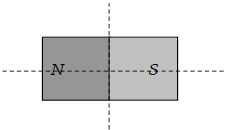
1. \(4T\)
2. \( T/4\)
3. \(T/2\)
4. \(T \)
A short magnetic needle is pivoted in a uniform magnetic field of strength 1 T. When another magnetic field of strength T is applied to the needle in a perpendicular direction, the needle deflects through an angle , where is
(1) 30
(2) 45
(3) 90
(4) 60
When ampere current is passed in a tangent galvanometer, there is a deflection of in it. The deflection obtained when 3 amperes current is passed, is
(1)
(2)
(3)
(4)
A thin rectangular magnet suspended freely has a period of oscillation equal to T. Now it is broken into two equal halves (each having half of the original length) and one piece is made to oscillate freely in the same field. If its period of oscillation is T, then ratio is
(1)
(2)
(3)
(4) 2
The length of a magnet is large compared to its width and breadth. The time period of its oscillation in a vibration magnetometer is 2 s. The magnet is cut along its length into three equal parts and three parts are then placed on each other with their like poles together. The time period of this combination will be
(1)
(2)
(3)
(4)
Relative permeability of iron is 5500, then its magnetic susceptibility will be
(1)
(2)
(3)
(4)
Two short magnets placed along the same axis with their like poles facing each other repel each other with a force which varies inversely as
1. Square of the distance
2. Cube of the distance
3. Distance
4. Fourth power of the distance
Two identical short bar magnets, each having magnetic moment M, are placed a distance of 2d apart with axes perpendicular to each other in a horizontal plane. The magnetic induction at a point midway between them is
(1)
(2)
(3)
(4)
If a magnet is suspended at an angle to the magnetic meridian, it makes an angle of with the horizontal. The real dip is
(1)
(2)
(3)
(4)
Two magnets of equal mass are joined at right angles to each other as shown the magnet 1 has a magnetic moment 3 times that of magnet 2. This arrangement is pivoted so that it is free to rotate in the horizontal plane. In equilibrium what angle will the magnet 1 subtend with the magnetic meridian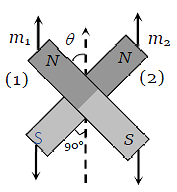
(1)
(2)
(3)
(4)
The dipole moment of each molecule of a paramagnetic gas is \(1.5\times10^{-23}~A-m^{2}.\) The temperature of the gas is and the number of molecules per unit volume in it are \(2\times10^{26}~m^{-3}.\) The maximum possible intensity of magnetization in the gas will be:
1. \(3\times10^{3}~A/m\)
2. \(4\times10^{-3}~A/m\)
3. \(5\times10^{5}~A/m\)
4. \(6\times10^{-4}~A/m\)
Two magnets A and B are identical and these are arranged as shown in the figure. Their length is negligible in comparison to the separation between them. A magnetic needle is placed between the magnets at point P which gets deflected through an angle under the influence of magnets. The ratio of distance and will be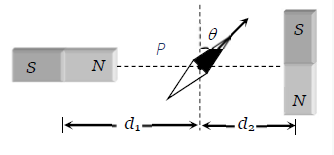
(1)
(2)
(3)
(4)
If and be the angles of dip observed in two vertical planes at right angles to each other and be the true angle of dip , then
(1)
(2)
(3)
(4)
Each atom of an iron bar ( has a magnetic moment 1.8
the density of iron is atomic weight is
56 and Avogadro's number is the magnetic moment of bar in the state of
magnetic saturation will be
1. 4.75 Am
2. 5.74 Am
3. 7.54 Am
4. 75.4 Am
For substances hysteresis (B -H) curves are given as shown in figure. For making a temporary magnet which of hte following is best.
1. 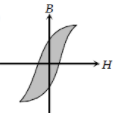
2. 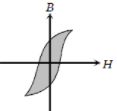
3. 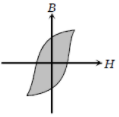
4. 
The relative permeability of a ferromagnetic substance varies with temperature (T) according to the curve 
1. A
2. B
3. C
4. D
The basic magnetization curve for a ferromagnetic material is shown in the figure. The value of relative permeability is highest for the point:
1. P
2. Q
3. R
4. S
The variation of hte intensity of magnetization (I) with respect to the magnetizing field (H) in a diamagnetic substance has described the graph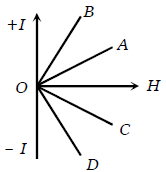
1. OD
2. OC
3. OB
4. OA